Spatial and Temporal Changes in Surface Water Area of Sri Lanka over a 30-Year Period
Abstract
1. Introduction
2. Materials and Methods
2.1. Study Area
2.2. Data Used
2.2.1. Landsat Images
2.2.2. Meteorological and GDP Data
2.3. Methods
2.3.1. Image Processing and Water Extraction
2.3.2. Surface Water Distribution and Inter- and Intra-Annual Variations Analysis
2.3.3. Correlate Water Area Variations and Driving Factors
3. Results
3.1. Accuracy Assessment of Water Extraction
3.2. Spatial Patterns of Surface Water Distribution
3.3. Interannual Variations
3.4. Intra-Annual Patterns and Variations
3.5. Correlation Between Water Area Variations and Climate and Anthropogenic Factors
3.6. Intra-Annual Variations of Senanayake Samudra and Padaviya Reservoirs in the Dry Zone
4. Discussion
4.1. Effects of Driving Factors on Surface Water Area Variation
4.2. Limitations and Future Improvements
4.3. Water Management Implications
5. Conclusions
- A total of 1607.73 km2 of the island is covered by permanent water (54.86%) and seasonal water (45.14%) with uneven spatial distributions: Dry zone (83.77%), Intermediate zone (12.46%), and Wet zone (3.77%).
- Overall, the seasonal water area showed a faster annual growth rate (7.06 ± 1.97 km2) together with permanent water (4.47 ± 2.08 km2) across the country.
- Sri Lanka showed the highest and the lowest amount of water areas during the DJF and MJJAS seasons.
- Precipitation and agricultural GDP indicated positive effects on surface water, while temperature showed a negative impact.
Author Contributions
Funding
Acknowledgments
Conflicts of Interest
References
- Pekel, J.F.; Cottam, A.; Gorelick, N.; Belward, A.S. High-resolution mapping of global surface water and its long-term changes. Nature 2016, 540, 418–422. [Google Scholar] [CrossRef] [PubMed]
- Zou, Z.; Dong, J.; Menarguez, M.A.; Xiao, X.; Qin, Y.; Doughty, R.B.; Hooker, K.V.; David Hambright, K. Continued decrease of open surface water body area in Oklahoma during 1984–2015. Sci. Total Environ. 2017, 595, 451–460. [Google Scholar] [CrossRef] [PubMed]
- Tulbure, M.G.; Broich, M. Spatiotemporal patterns and effects of climate and land use on surface water extent dynamics in a dryland region with three decades of Landsat satellite data. Sci. Total Environ. 2019, 658, 1574–1585. [Google Scholar] [CrossRef] [PubMed]
- Keller, A.; Sakthivadivel, R.; Seckler, D. Water scarcity and the role of storage in development. Int. Water Manag. Inst. 2000, 39, 1–24. [Google Scholar] [CrossRef]
- Amarasinghe, U.A.; Mutuwatta, L.; Sakthivadivel, R. Water Scarcity Variations within a Country: A Case Study of Sri Lanka; Research Report; International Water Management Institute (IWMI): Colombo, Sri Lanka, 1999; Volume 32. [Google Scholar] [CrossRef]
- Bandara, K.M.P. Monitoring irrigation performance in Sri Lanka with high-frequency satellite measurements during the dry season. Agric. Water Manag. 2003, 58, 159–170. [Google Scholar] [CrossRef]
- Department of Meteorology, Sri Lanka. Available online: http://www.meteo.gov.lk (accessed on 21 February 2020).
- Naveendrakumar, G.; Vithanage, M.; Kwon, H.-H.; Chandrasekara, S.S.K.; Iqbal, M.C.M.; Pathmarajah, S.; Fernando, W.C.D.K.; Obeysekera, J. South Asian perspective on temperature and rainfall extremes: A review. Atmos. Res. 2019, 225, 110–120. [Google Scholar] [CrossRef]
- Hemachandra, E.M.G.P.; Dayawansa, N.D.K.; De Silva, R.P. Developing a Composite Map of Vulnerability to Rainfall Extremes in Sri Lanka. In Water, Flood Management and Water Security under a Changing Climate; Springer International Publishing: Cham, Switzerland, 2020; pp. 63–84. [Google Scholar]
- Eckstein, D.; Hutfils, M.; Winges, M. Global Climate Risk Index 2019; Germanwatch: Bonn, Germany, 2018; ISBN 9783943704709. [Google Scholar]
- Bastiaanssen, W.G.M.; Chandrapala, L. Water balance variability across Sri Lanka for assessing agricultural and environmental water use. Agric. Water Manag. 2003, 58, 171–192. [Google Scholar] [CrossRef]
- Malmgren, B.A.; Hulugalla, R.; Hayashi, Y.; Mikami, T. Precipitation trends in Sri Lanka since the 1870s and relationships to El Niño-southern oscillation. Int. J. Climatol. 2003, 23, 1235–1252. [Google Scholar] [CrossRef]
- Wickramagamage, P. Seasonality and spatial pattern of rainfall of Sri Lanka: Exploratory factor analysis. Int. J. Climatol. 2010, 30, 1235–1245. [Google Scholar] [CrossRef]
- De Silva, C.S.; Weatherhead, E.K.; Knox, J.W.; Rodriguez-Diaz, J.A. Predicting the impacts of climate change—A case study of paddy irrigation water requirements in Sri Lanka. Agric. Water Manag. 2007, 93, 19–29. [Google Scholar] [CrossRef]
- Burchfield, E.K.; Gilligan, J. Agricultural adaptation to drought in the Sri Lankan dry zone. Appl. Geogr. 2016, 77, 92–100. [Google Scholar] [CrossRef]
- Abeysekera, A.B.; Punyawardena, B.V.R.; Premalal, K.H.M.S. Recent trends of extreme positive rainfall anomalies in the dry zone of Sri Lanka. Trop. Agric. 2015, 163, 1–23. [Google Scholar]
- Burt, T.; Weerasinghe, K. Rainfall Distributions in Sri Lanka in Time and Space: An Analysis Based on Daily Rainfall Data. Climate 2014, 2, 242–263. [Google Scholar] [CrossRef]
- Shah, T.; Samad, M.; Ariyaratne, R.; Jinapala, K. Ancient Small-Tank Irrigation in Sri Lanka Continuity and Change. Econ. Polit. Wkly. 2013, 58, 58–65. [Google Scholar]
- Köpke, S.; Withanachchi, S.S.; Pathiranage, R.; Withanachchi, C.R.; Ploeger, A. Social—Ecological dynamics in irrigated agriculture in dry zone Sri Lanka: A political ecology. Sustain. Water Resour. Manag. 2019, 5, 629–637. [Google Scholar] [CrossRef]
- Prigent, C.; Papa, F.; Aires, F.; Jimenez, C.; Rossow, W.B.; Matthews, E. Changes in land surface water dynamics since the 1990s and relation to population pressure. Geophys. Res. Lett. 2012, 39, 1–5. [Google Scholar] [CrossRef]
- Mueller, N.; Lewis, A.; Roberts, D.; Ring, S.; Melrose, R.; Sixsmith, J.; Lymburner, L.; McIntyre, A.; Tan, P.; Curnow, S.; et al. Water observations from space: Mapping surface water from 25years of Landsat imagery across Australia. Remote Sens. Environ. 2016. [Google Scholar] [CrossRef]
- Heimhuber, V.; Tulbure, M.G.; Broich, M. Addressing spatio-temporal resolution constraints in Landsat and MODIS-based mapping of large-scale floodplain inundation dynamics. Remote Sens. Environ. 2018, 211, 307–320. [Google Scholar] [CrossRef]
- Deng, Y.; Jiang, W.; Tang, Z.; Li, J.; Lv, J.; Chen, Z.; Jia, K. Spatio-Temporal Change of Lake Water Extent in Wuhan Urban Agglomeration Based on Landsat Images from 1987 to 2015. Remote Sens. 2017, 9, 270. [Google Scholar] [CrossRef]
- Che, X.; Feng, M.; Sexton, J.; Channan, S.; Sun, Q.; Ying, Q.; Liu, J.; Wang, Y. Landsat-Based Estimation of Seasonal Water Cover and Change in Arid and Semi-Arid Central Asia (2000–2015). Remote Sens. 2019, 11, 1323. [Google Scholar] [CrossRef]
- Tulbure, M.G.; Broich, M. Spatiotemporal dynamic of surface water bodies using Landsat time-series data from 1999 to 2011. ISPRS J. Photogramm. Remote Sens. 2013, 79, 44–52. [Google Scholar] [CrossRef]
- Tulbure, M.G.; Broich, M.; Stehman, S.V. Spatiotemporal dynamics of surface water extent from three decades of seasonally continuous landsat time series at subcontinental scale. ISPRS Int. Arch. Photogramm. Remote Sens. Spat. Inf. Sci. 2016, XLI-B8, 403–404. [Google Scholar] [CrossRef]
- Wang, Y.; Ma, J.; Xiao, X.; Wang, X.; Dai, S.; Zhao, B. Long-Term Dynamic of Poyang Lake Surface Water: A Mapping Work Based on the Google Earth Engine Cloud Platform. Remote Sens. 2019, 11, 313. [Google Scholar] [CrossRef]
- Souza, C.; Kirchhoff, F.; Oliveira, B.; Ribeiro, J.; Sales, M. Long-Term Annual Surface Water Change in the Brazilian Amazon Biome: Potential Links with Deforestation, Infrastructure Development and Climate Change. Water 2019, 11, 566. [Google Scholar] [CrossRef]
- Wang, M.; Du, L.; Ke, Y.; Huang, M.; Zhang, J.; Zhao, Y.; Li, X.; Gong, H.; Wang, M.; Du, L.; et al. Impact of Climate Variabilities and Human Activities on Surface Water Extents in Reservoirs of Yongding River Basin, China, from 1985 to 2016 Based on Landsat Observations and Time Series Analysis. Remote Sens. 2019, 11, 560. [Google Scholar] [CrossRef]
- Feng, M.; Sexton, J.O.; Channan, S.; Townshend, J.R. A global, high-resolution (30-m) inland water body dataset for 2000: First results of a topographic–spectral classification algorithm. Int. J. Digit. Earth 2016, 9, 113–133. [Google Scholar] [CrossRef]
- Zou, Z.; Xiao, X.; Dong, J.; Qin, Y.; Doughty, R.B.; Menarguez, M.A.; Zhang, G.; Wang, J. Divergent trends of open-surface water body area in the contiguous United States from 1984 to 2016. Proc. Natl. Acad. Sci. USA 2018, 115, 3810–3815. [Google Scholar] [CrossRef]
- Deng, Y.; Jiang, W.; Tang, Z.; Ling, Z.; Wu, Z. Long-Term Changes of Open-Surface Water Bodies in the Yangtze River Basin Based on the Google Earth Engine Cloud Platform. Remote Sens. 2019, 11, 2213. [Google Scholar] [CrossRef]
- Pickens, A.H.; Hansen, M.C.; Hancher, M.; Stehman, S.V.; Tyukavina, A.; Potapov, P.; Marroquin, B.; Sherani, Z. Mapping and sampling to characterize global inland water dynamics from 1999 to 2018 with full Landsat time-series. Remote Sens. Environ. 2020, 243, 111792. [Google Scholar] [CrossRef]
- Tulbure, M.G.; Broich, M.; Stehman, S.V.; Kommareddy, A. Surface water extent dynamics from three decades of seasonally continuous Landsat time series at subcontinental scale in a semi-arid region. Remote Sens. Environ. 2016, 178, 142–157. [Google Scholar] [CrossRef]
- Atapattu, S.; Wickremasinghe, C.S. Sri Lanka’s Gal Oya National Park: Aspects and prospects. Biol. Conserv. 1974, 6, 219–222. [Google Scholar] [CrossRef]
- Central bank of Sri Lanka. Available online: https://www.cbsl.gov.lk (accessed on 3 January 2020).
- Kohonen, T. Improved versions of learning vector quantization. In Proceedings of the 1990 IJCNN International Joint Conference on Neural Networks, San Diego, CA, USA, 17–21 June 1990; IEEE: New York, NY, USA, 1990; Volume 1, pp. 545–550. [Google Scholar]
- Wang, Z.; Nasrabadi, N.M.; Huang, T.S. Spatial–Spectral Classification of Hyperspectral Images Using Discriminative Dictionary Designed by Learning Vector Quantization. IEEE Trans. Geosci. Remote Sens. 2014, 52, 4808–4822. [Google Scholar] [CrossRef]
- Somasundaram, D.; Zhang, F.; Wang, S.; Ye, H.; Zhang, Z.; Zhang, B. Learning vector quantization neural network for surface water extraction from Landsat OLI images. J. Appl. Remote Sens. 2020, 14, 1. [Google Scholar] [CrossRef]
- Zhang, G.; Yao, T.; Chen, W.; Zheng, G.; Shum, C.K.; Yang, K.; Piao, S.; Sheng, Y.; Yi, S.; Li, J.; et al. Regional differences of lake evolution across China during 1960s–2015 and its natural and anthropogenic causes. Remote Sens. Environ. 2019, 221, 386–404. [Google Scholar] [CrossRef]
- Murat, M.; Malinowska, I.; Hoffmann, H.; Baranowski, P. Statistical modelling of agrometeorological time series by exponential smoothing. Int. Agrophys. 2016, 30, 57–65. [Google Scholar] [CrossRef]
- Lamb, P.J. Persistence of Subsaharan drought. Nature 1982, 299, 46–48. [Google Scholar] [CrossRef]
- Naveendrakumar, G.; Vithanage, M.; Kwon, H.; Iqbal, M.C.M.; Pathmarajah, S.; Obeysekera, J. Five Decadal Trends in Averages and Extremes of Rainfall and Temperature in Sri Lanka. Adv. Meteorol. 2018, 2018, 4217917. [Google Scholar] [CrossRef]
- Zubair, L. El Niño-southern oscillation influences on the Mahaweli streamflow in Sri Lanka. Int. J. Climatol. 2003, 23, 91–102. [Google Scholar] [CrossRef]
- Marambe, B. Effect of El Niño Southern Oscillation (ENSO) events on inter-seasonal variability of rainfall in Wet and Intermediate zones of Sri Lanka. Trop. Agric. 2019, 167, 14–27. [Google Scholar]
- Murray-Rust, H.; Sakthivadivel, R.; Amarasinghe, U.A. Impact Assessment of Organizing Farmers in the Gal Oya Left Bank Irrigation Scheme, Sri Lanka. Int. J. Water Resour. Dev. 1999, 15, 197–217. [Google Scholar] [CrossRef]
- Department of Irrigation. Available online: https://www.irrigation.gov.lk/ (accessed on 27 April 2020).
- Ministry of Agriculture, Irrigation, and Mahaweli Development of Sri Lanka. Sri Lanka National Water Development Report; Imbulana, K., Wijesekera, N.T.S., Neupane, B.R., Eds.; UNESDOC: Paris, France, 2006. [Google Scholar]
- Food and Agriculture Organization of the United Nations. Available online: http://www.fao.org/home/en/ (accessed on 27 May 2020).
- Stocker, T.F.; Qin, D.; Plattner, G.K.; Tignor, M.; Allen, S.K.; Boschung, J.; Nauels, A.; Xia, Y.; Bex, V.; Midgley, P.M. (Eds.) IPCC, 2013: Climate Change 2013: The Physical Science Basis; IPCC: Geneva, Switzerland, 2013; Volume 1535. [Google Scholar]
- Rathnayake, C.W.M.; Jones, S.; Soto-Berelov, M. Mapping Land Cover Change over a 25-Year Period (1993–2018) in Sri Lanka Using Landsat Time-Series. Land 2020, 9, 27. [Google Scholar] [CrossRef]
- Dharmasena, P.B. Magnitude of sedimentation in Village tanks. Trop. Agric. 1992, 148, 97–110. [Google Scholar]
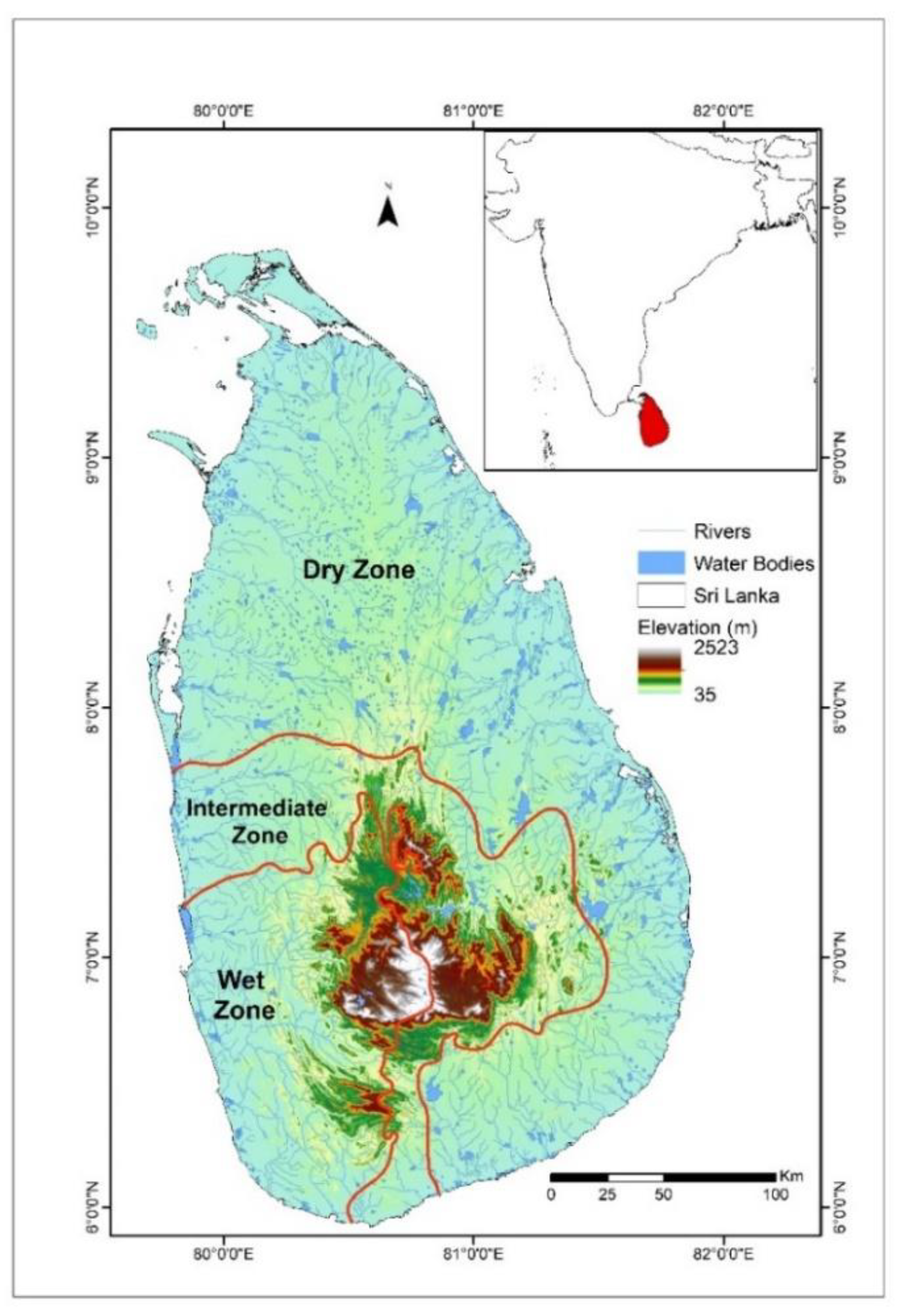
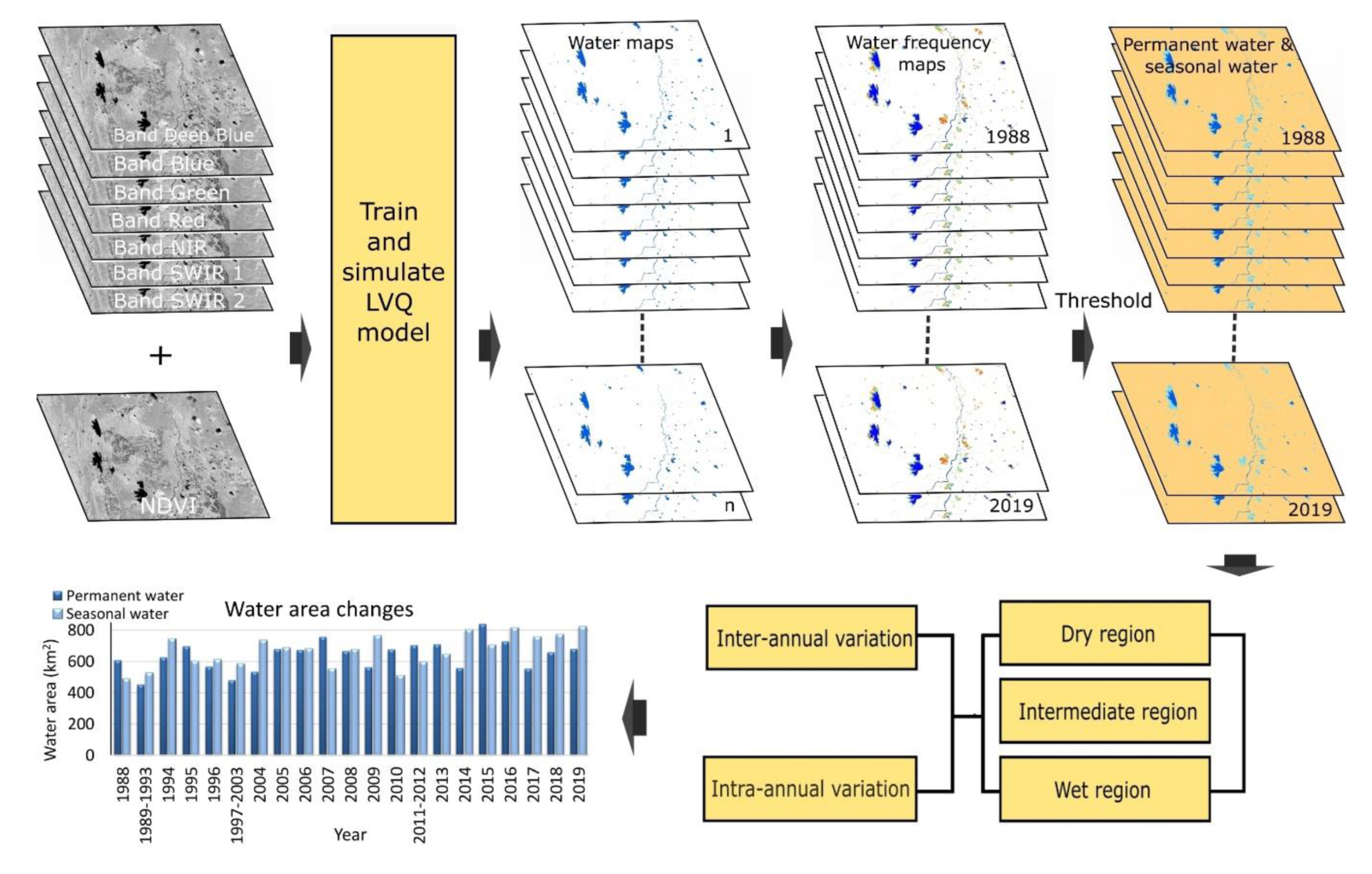



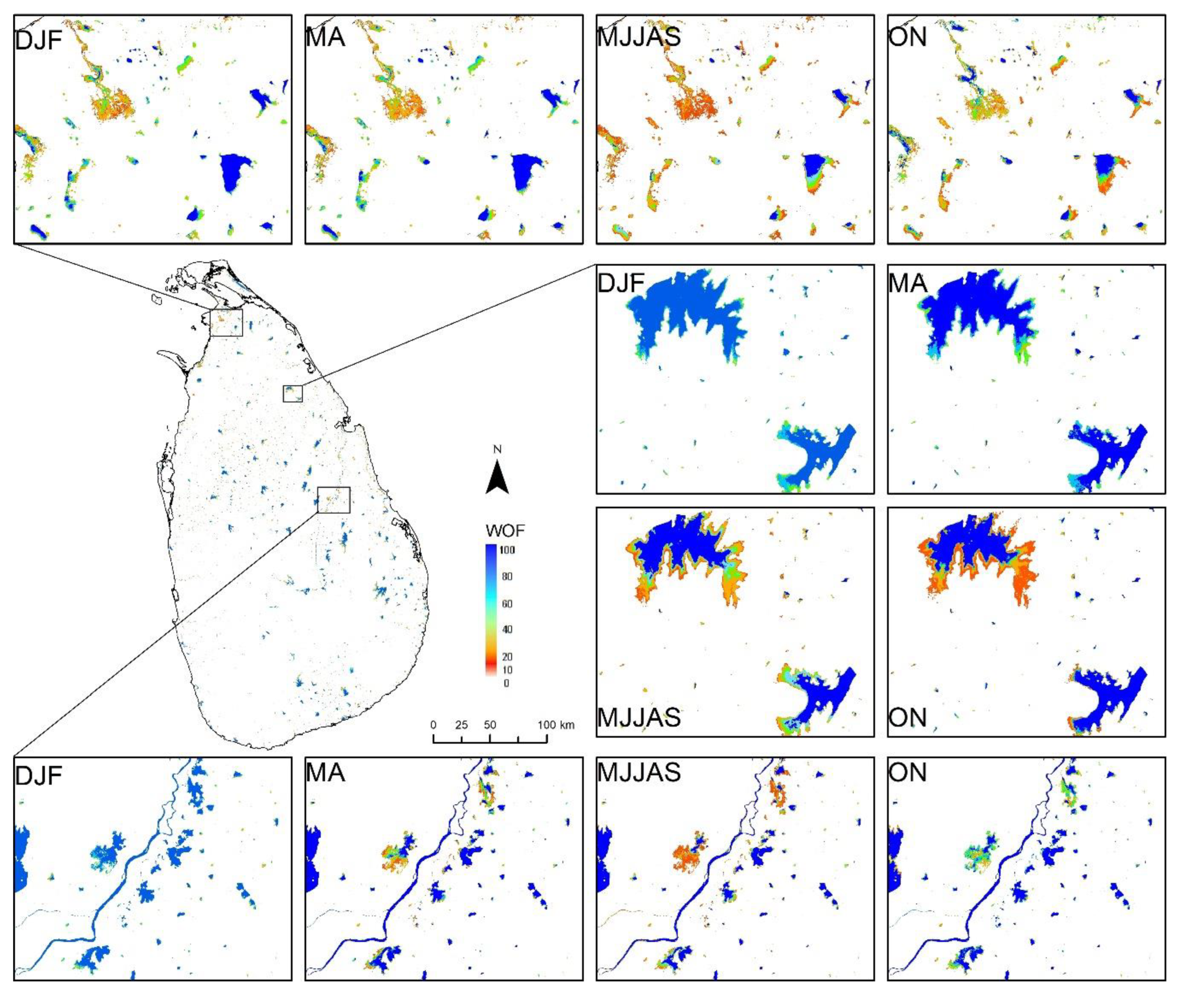
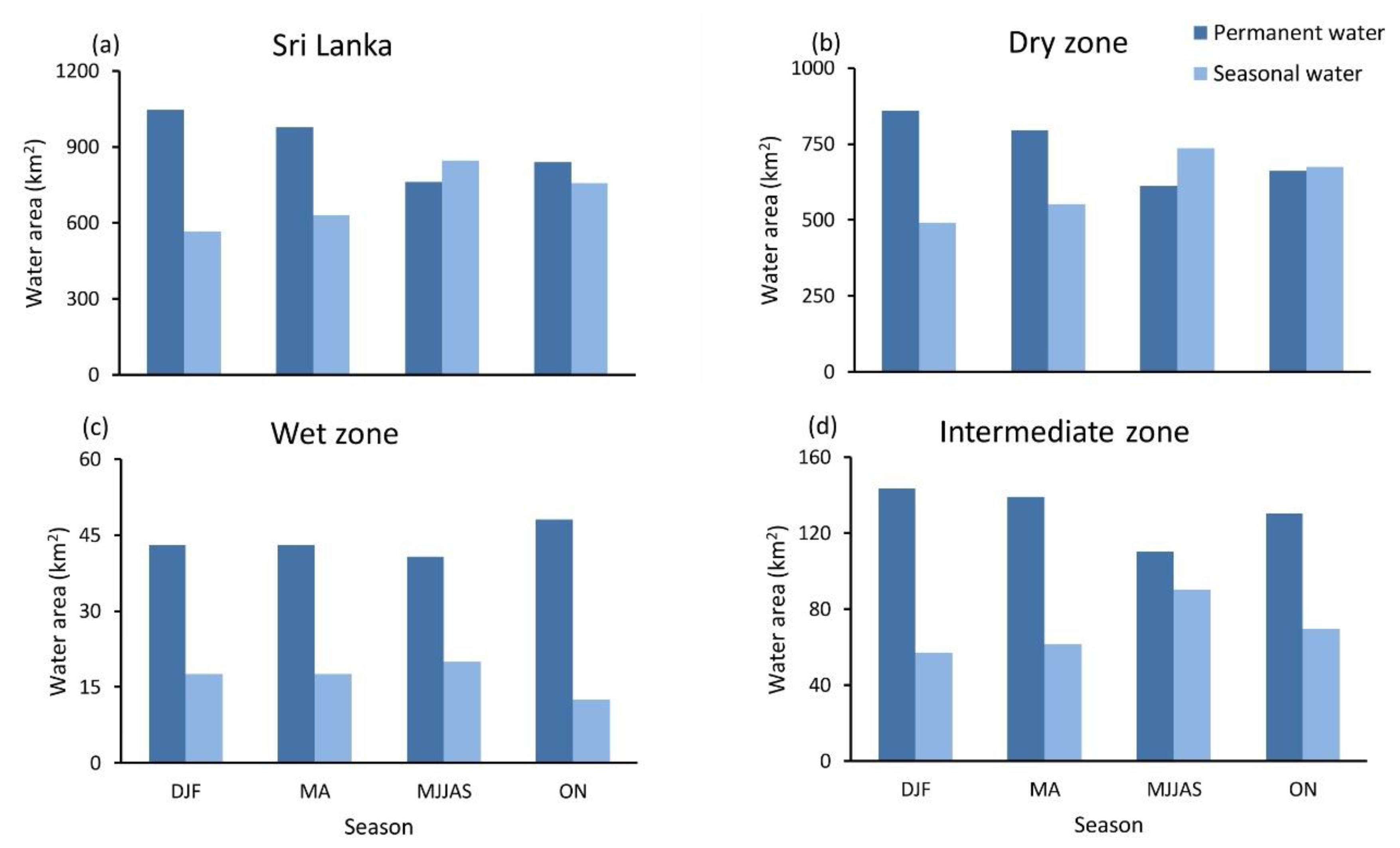


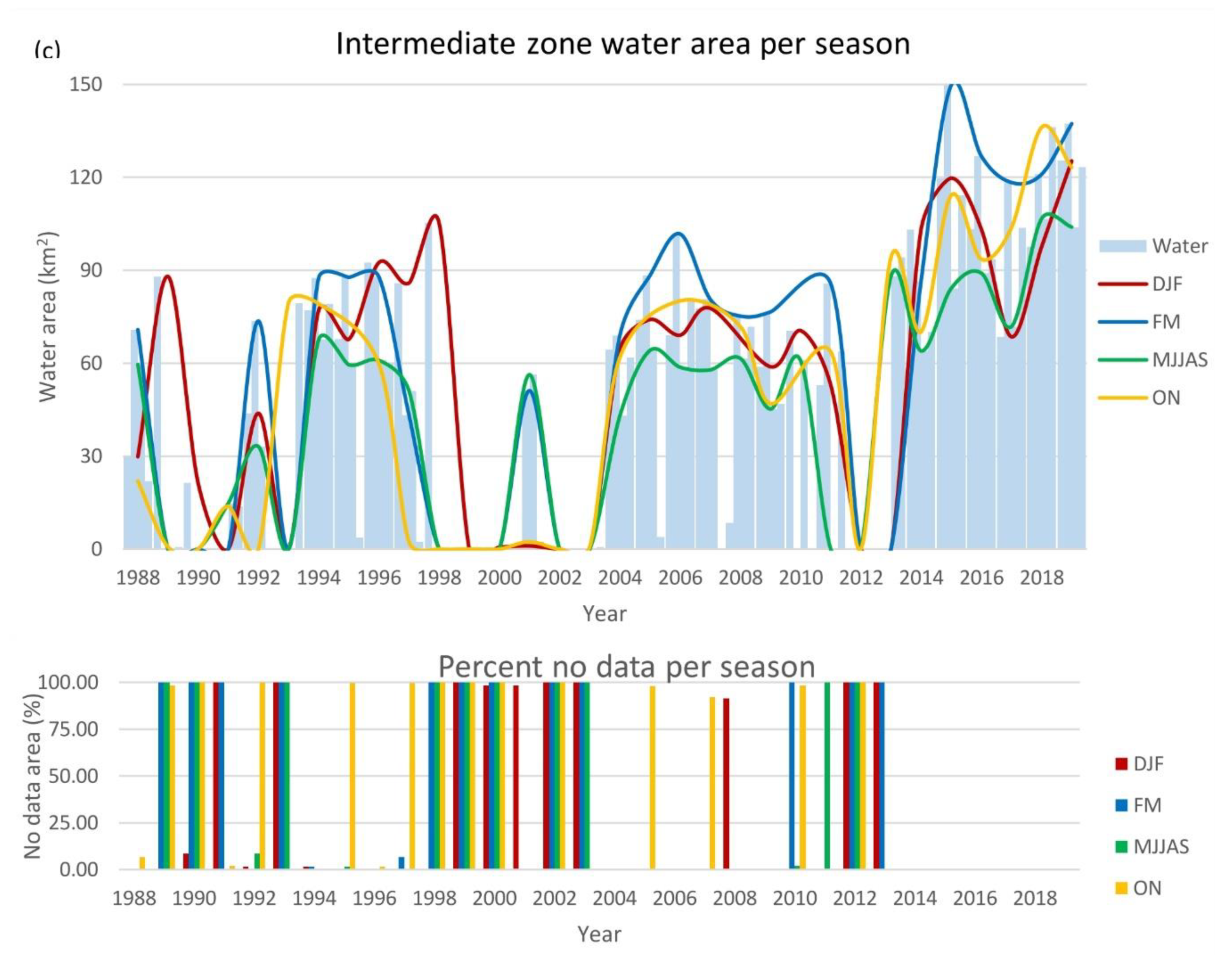

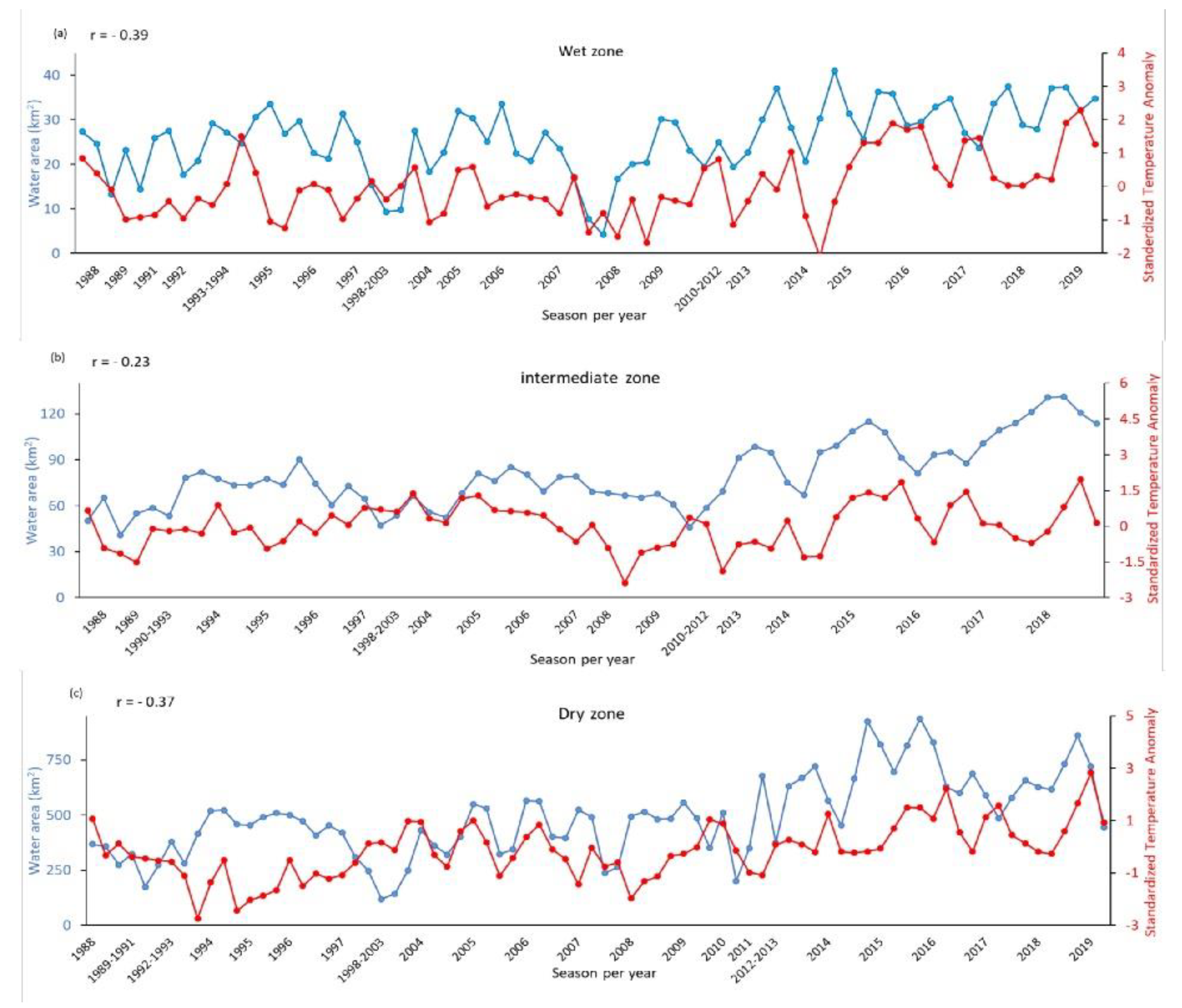

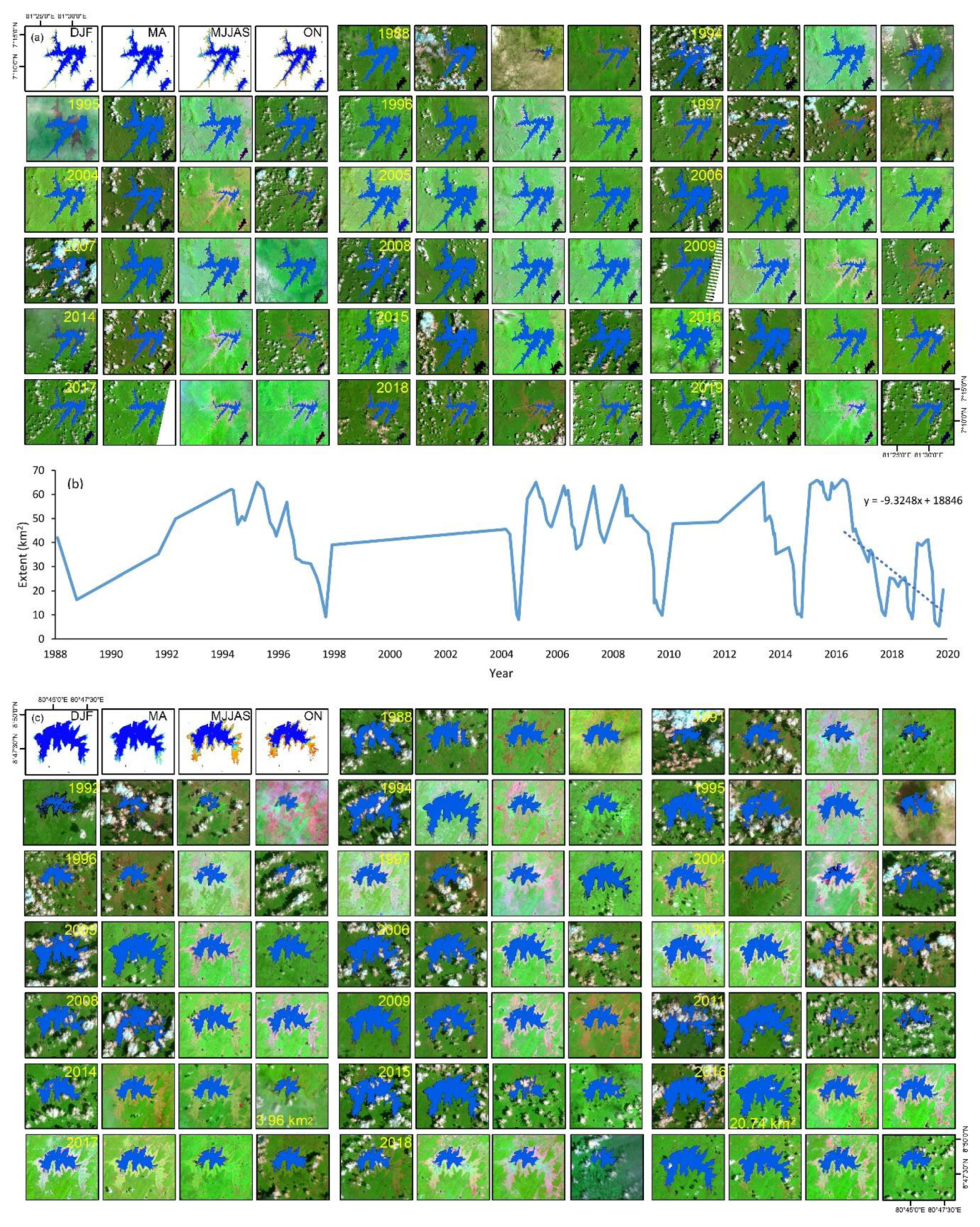
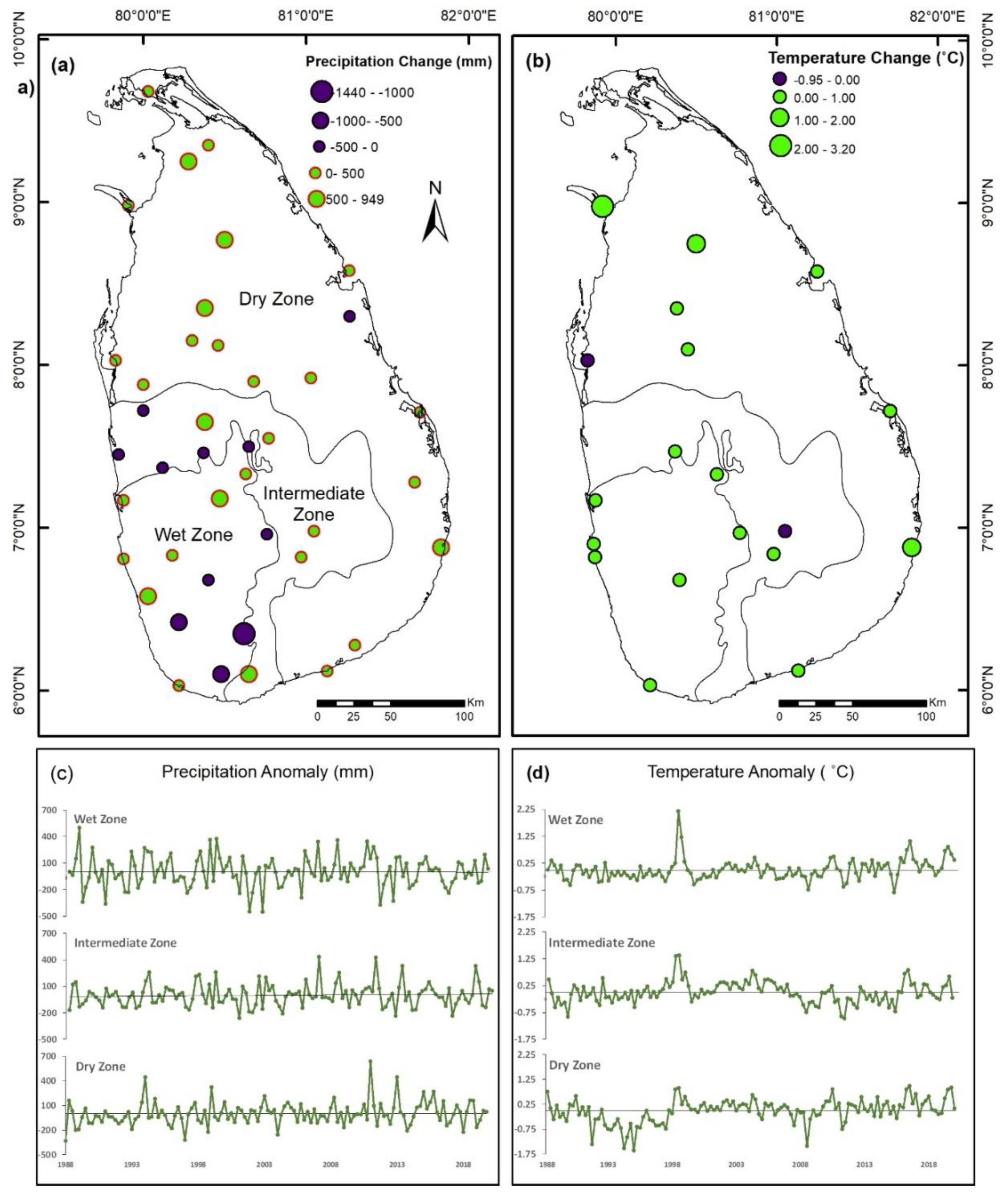
| Sensor | Path/Row | Total | ||||||||
|---|---|---|---|---|---|---|---|---|---|---|
| 140/55 | 140/56 | 141/53 | 141/54 | 141/55 | 141/56 | 142/53 | 142/54 | 142/55 | ||
| TM (1987–2011) | 143 | 108 | 167 | 162 | 156 | 117 | 140 | 150 | 118 | 1261 |
| OLI (2013–2019) | 106 | 106 | 98 | 127 | 99 | 92 | 106 | 116 | 104 | 954 |
| Total | 249 | 214 | 265 | 289 | 255 | 209 | 246 | 266 | 222 | 2215 |
| Landsat 5 TM (Number of Samples = 6801) | Landsat 8 OLI (Number of Samples = 11,523) | ||||||||||
|---|---|---|---|---|---|---|---|---|---|---|---|
| Map | Map | ||||||||||
| Water | No-Water | Total | Producer’s Accuracy | Water | No-Water | Total | Producer’s Accuracy | ||||
| Reference | Water | 499 | 3 | 502 | 99.40 | Reference | Water | 405 | 6 | 411 | 98.54 |
| No-water | 4 | 6295 | 6299 | 99.94 | No-water | 4 | 11,108 | 11,112 | 99.96 | ||
| Total | 503 | 6298 | 6801 | Total | 409 | 11,114 | 11,523 | ||||
| User’s accuracy | 99.20 | 99.95 | 99.90 | User’s accuracy | 99.02 | 99.95 | 99.93 | ||||
| Zone | Surface Water of Sri Lanka (km2) | |||||
|---|---|---|---|---|---|---|
| Seasonal (WOF%) | Permanent (WOF%) | Total | ||||
| 10–20 | 20–40 | 40–60 | 60–80 | 80–100 | ||
| Dry | 161.61 | 191.35 | 152.75 | 128.62 | 712.46 | 1346.78 |
| Intermediate | 13.68 | 21.35 | 17.97 | 20.69 | 126.65 | 200.33 |
| Wet | 3.32 | 6.03 | 4.60 | 3.75 | 42.90 | 60.62 |
| Total | 178.61 | 218.73 | 175.32 | 153.06 | 882.01 | 1607.73 |
Publisher’s Note: MDPI stays neutral with regard to jurisdictional claims in published maps and institutional affiliations. |
© 2020 by the authors. Licensee MDPI, Basel, Switzerland. This article is an open access article distributed under the terms and conditions of the Creative Commons Attribution (CC BY) license (http://creativecommons.org/licenses/by/4.0/).
Share and Cite
Somasundaram, D.; Zhang, F.; Ediriweera, S.; Wang, S.; Li, J.; Zhang, B. Spatial and Temporal Changes in Surface Water Area of Sri Lanka over a 30-Year Period. Remote Sens. 2020, 12, 3701. https://doi.org/10.3390/rs12223701
Somasundaram D, Zhang F, Ediriweera S, Wang S, Li J, Zhang B. Spatial and Temporal Changes in Surface Water Area of Sri Lanka over a 30-Year Period. Remote Sensing. 2020; 12(22):3701. https://doi.org/10.3390/rs12223701
Chicago/Turabian StyleSomasundaram, Deepakrishna, Fangfang Zhang, Sisira Ediriweera, Shenglei Wang, Junsheng Li, and Bing Zhang. 2020. "Spatial and Temporal Changes in Surface Water Area of Sri Lanka over a 30-Year Period" Remote Sensing 12, no. 22: 3701. https://doi.org/10.3390/rs12223701
APA StyleSomasundaram, D., Zhang, F., Ediriweera, S., Wang, S., Li, J., & Zhang, B. (2020). Spatial and Temporal Changes in Surface Water Area of Sri Lanka over a 30-Year Period. Remote Sensing, 12(22), 3701. https://doi.org/10.3390/rs12223701







